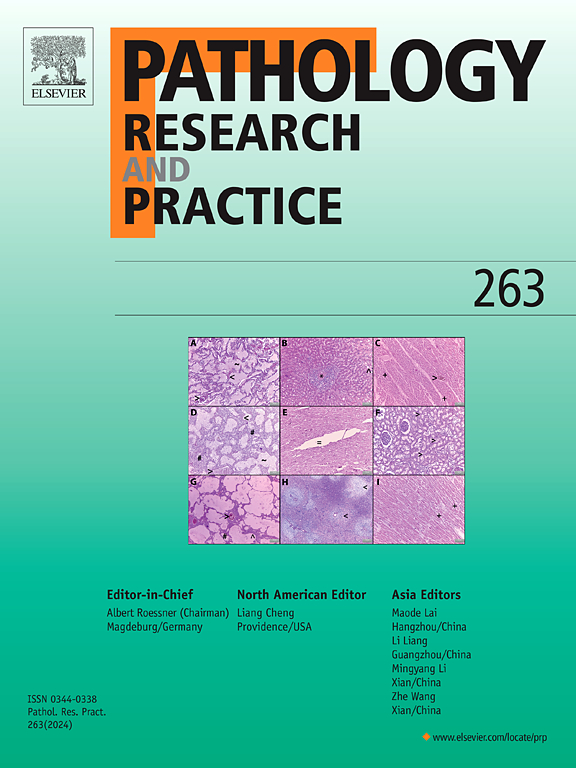干扰素α -2b (IFNα2b)在精确肿瘤学中的应用:传递和组合免疫治疗的创新
IF 2.9
4区 医学
Q2 PATHOLOGY
引用次数: 0
摘要
干扰素α -2b (IFNα2b)自20世纪80年代获得FDA批准以来,一直是癌症免疫治疗的关键药物,具有直接和间接的抗癌作用。它通过Bax/Bcl-2调控直接触发细胞周期阻滞和死亡,并抑制血管生成,主要由JAK-STAT系统介导,该系统激活300多种干扰素刺激基因(ISGs)。IFNα2b通过增强自然杀伤细胞(NK)毒性、促进树突状细胞(DC)成熟、促进T细胞活化,同时抑制调节性T细胞(Tregs)和免疫抑制因子(如TGF-β),间接增强免疫监视。临床上,IFNα2b在黑色素瘤、肾细胞癌(RCC)和血液系统恶性肿瘤中显示出有效性。在III期黑色素瘤中,高剂量IFNα2b可提高无复发生存率,使复发率降低28% %。RCC对IFNα2b和白细胞介素-2有应答,客观应答率为18% %,但慢性髓性白血病(CML)在36个月时的生存率为76% %。联合治疗,特别是结合免疫检查点抑制剂(如pembrolizumab)的联合治疗,在晚期黑色素瘤的疗效增强,客观缓解率为60% %。聚乙二醇化(将半衰期延长至48-72 h)和Probody技术(Pb-IFNα2b)等创新提高了安全性和肿瘤特异性。尽管如此,障碍仍然存在,包括剂量限制性毒性、与JAK-STAT失调相关的耐药性和免疫抑制肿瘤微环境。诸如基于树突状细胞的疫苗接种、生物标志物驱动的患者分层和复杂的递送方法等创新方法试图克服这些障碍。随着精准肿瘤学的发展,IFNα2b继续成为必不可少的治疗药物,将其历史意义与面向未来的免疫治疗联系起来。本文章由计算机程序翻译,如有差异,请以英文原文为准。
Interferon alpha-2b (IFNα2b) in precision oncology: Innovations in delivery and combinatorial immunotherapy
Interferon alpha-2b (IFNα2b) has been a pivotal drug in cancer immunotherapy since its FDA approval in the 1980s, demonstrating both direct and indirect anticancer benefits. It directly triggers cell cycle arrest and death via Bax/Bcl-2 regulation and inhibits angiogenesis, primarily mediated by the JAK-STAT system, which activates over 300 interferon-stimulated genes (ISGs). IFNα2b indirectly increases immune surveillance by augmenting natural killer (NK) cell cytotoxicity, facilitating dendritic cell (DC) maturation, and bolstering T-cell activation, while concurrently inhibiting regulatory T cells (Tregs) and immunosuppressive cytokines such as TGF-β. Clinically, IFNα2b has shown effectiveness in melanoma, renal cell carcinoma (RCC), and hematologic malignancies. In stage III melanoma, high-dose IFNα2b enhances relapse-free survival, decreasing recurrence by 28 %. RCC exhibits a response to IFNα2b in conjunction with interleukin-2, attaining an 18 % objective response rate, but chronic myelogenous leukemia (CML) demonstrates a 76 % survival rate at 36 months. Combination therapy, particularly those incorporating immune checkpoint inhibitors such as pembrolizumab, have enhanced results in advanced melanoma, with objective response rates of 60 %. Innovations like pegylation (prolonging half-life to 48–72 h) and Probody technology (Pb-IFNα2b) enhance safety and tumor specificity. Nonetheless, obstacles persist, including as dose-limiting toxicities, resistance associated with JAK-STAT dysregulation, and immunosuppressive tumor microenvironments. Innovative approaches like as dendritic cell-based vaccinations, biomarker-driven patient stratification, and sophisticated delivery methods seek to surmount these obstacles. As precision oncology advances, IFNα2b continues to be an essential therapeutic agent, connecting its historical significance with future-oriented immunotherapy.
求助全文
通过发布文献求助,成功后即可免费获取论文全文。
去求助
来源期刊
CiteScore
5.00
自引率
3.60%
发文量
405
审稿时长
24 days
期刊介绍:
Pathology, Research and Practice provides accessible coverage of the most recent developments across the entire field of pathology: Reviews focus on recent progress in pathology, while Comments look at interesting current problems and at hypotheses for future developments in pathology. Original Papers present novel findings on all aspects of general, anatomic and molecular pathology. Rapid Communications inform readers on preliminary findings that may be relevant for further studies and need to be communicated quickly. Teaching Cases look at new aspects or special diagnostic problems of diseases and at case reports relevant for the pathologist''s practice.

 求助内容:
求助内容: 应助结果提醒方式:
应助结果提醒方式:


